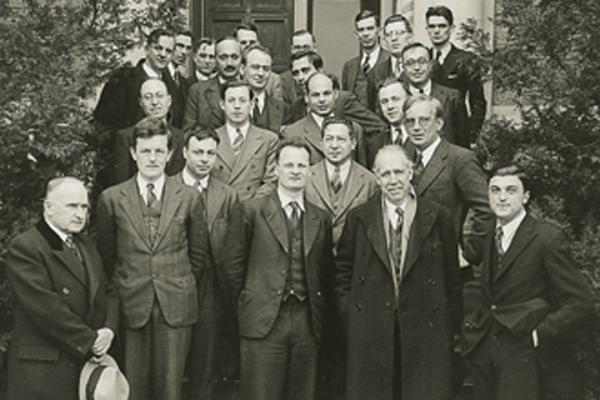History of Astrophysics at GW
During the summer of 1934, GW President Cloyd Heck Marvin, recognizing the rapid advancement of the new quantum theory and nuclear physics, wanted to further promote the sciences at the university. Following the advice of Merle Tuve, then-director of the accelerator laboratory at the Carnegie Institution of Washington, Marvin brought on theoretician and renowned physicist George Gamow to the university’s Physics Department.
Gamow agreed to come under several conditions: He wanted to bring friend and colleague Edward Teller, and he wanted the resources to organize yearly conferences on current topics in physics. Marvin agreed, and thus began a tradition of bringing together some of the country’s greatest scientific minds for conferences on GW’s campus, jointly sponsored by GW and the Carnegie Institution.
Washington Conferences on Theoretical Physics
1935: Nuclear Physics
Attendees included Hans Bethe and George Uhlenbeck. Discussion involved why the magnetic moment of proton differs from electron, theories of gamma radiation and of beta decay.
1936: Molecular Physics
The topic was Edward Teller's bailiwick. Attendees included Hans Bethe, Harold Urey, Linus Pauling, James Franck, Karl Herzfeld, Gregory Breit, R.H. Fowler, Eugene Wigner and Maria Goeppert Mayer. Discussions on the nature of chemical bonds, nuclear isotopes and radioactivity.
1937: Problems of Elementary Particles and Nuclear Physics
Attendees included Niels Bohr, I.I. Rabi and John Wheeler. Bohr elaborated on Gamow's liquid drop model of the nucleus; there were also discussions of the Gamow-Teller theory for spin-flip nuclear beta decay, adding to Fermi's original theory.
1938: Stellar Energy and Nuclear Processes
At this conference, Hans Bethe was inspired to investigate those processes that produce energy in stars. On his way back to Cornell University, Bethe determined all the important nuclear reactions involved, and within a week calculated the observed luminosity of the sun. He received the 1967 Nobel Prize for this work.
1939: Low Temperature Physics and Superconductivity
Attendees included Fritz London, who presented his work on superfluid liquid helium. Also present were Breit, Urey, Fermi, Uhlenbeck, Van Vleck, I.I. Rabi, Otto Stern, Leon Rosenfeld and Bohr.
The most famous event at this 5th Washington Conference on Theoretical Physics came from the announcement by Niels Bohr at the 1939 conference, in the Hall of Government, room 209, that the nucleus of uranium had been split by bombardment with neutrons, with significant energy released. This was the dawn of the atomic age.
1940: Geophysics and the Interior of the Earth
This Conference had as its objectives: (a) To formulate the problems and data of geophysics which may be of interest to workers in theoretical physics and (b) to put at the service of workers in geophysics a growing theoretical knowledge concerning the behavior of matter under unusual conditions, especially at very high pressures.
1941: Elementary Particles
Robert Oppenheimer spoke on the theory of mesons.
1942: Stellar Evolution and Cosmology
Gamow spoke about his new ideas on cosmological nucleosynthesis.
1946: Physics of Living Matter
Gamow wanted to understand how living things worked. So, he selected the topic of the 1946 conference to be on the physics of life. The invitees were among the most prominent physicists and biophysicists in the world. A few years later in 1953, within a few months after James Watson and Francis Crick discovered the structure of DNA, Dr. Gamow was the first to ask how the DNA structure codes for proteins, and then suggest a solution.
1947: Gravitation and Electromagnetism
The 1947 conference focused on the new field of quantum electrodynamics and developments in gravitation theory. Participating were Richard Feynman and Julian Schwinger, just at the time when they were independently developing methods for calculating the observable effects of quantum fluctuations in electromagnetic fields. For this insight, they, together with Sin-Itiro Tomonaga in Japan, were awarded the Nobel Prize in 1965.
Gamow and the Big Bang
One of the fields that interested Gamow was cosmology: How did the universe and its elements come about? He made stellar evolution and cosmology the focus of the 1942 conference. After World War II, in October of 1945, he wrote to his friend Niels Bohr that he was engaged in "studying the problem of the origin of elements at the early states of the expanding universe. It means bringing together the relativistic formulae for expansion and the rates of thermonuclear and fission reactions." The result of this thinking was his 1948 “hot big bang theory,” correctly predicting the ratio of helium to hydrogen in the universe. He also predicted that there should be relic radiation left over from the big bang.
Astronomy Expands
In 1959, Herman Hedberg Hobbs joined the Physics Department faculty and began growing astronomy into a popular science elective across Columbian College throughout the 1970s. Teaching two or three lecture sections a semester, each section with up to 120 students, Hobbs engaged each student's natural sense of wonder and motivated a number of initially non-science majors to become physicists. Some of those students later became prominent in their field. Hobbs’s research into the growth of metallic whiskers was supported by NASA.
Founding the GW Astrophysics Group
In 2005, Professor Kalvir Dhuga organized the GW Astrophysics Group, with founding members including professors Dhuga, Ali Eskandarian, Leonard Maximon and William Parke. These initial members all had experience in either theoretical or experimental nuclear physics and decided to actively pursue research into high-energy astrophysics. They applied their knowledge of the behavior of nuclear and elementary particles to the outstanding questions involving the behavior of compact astrophysical bodies, including X-ray binaries, cataclysmic variables, gamma-ray bursters, neutron stars and black holes — all objects that emit high-energy radiation detectable here on Earth.
The Astrophysics Group has expanded to include members of the National Academy of Sciences and internationally renowned scientists, in particular on magnetars and gamma-ray bursts. The Astrophysics Group continues to grow with undergraduate and graduate students and postdocs.


